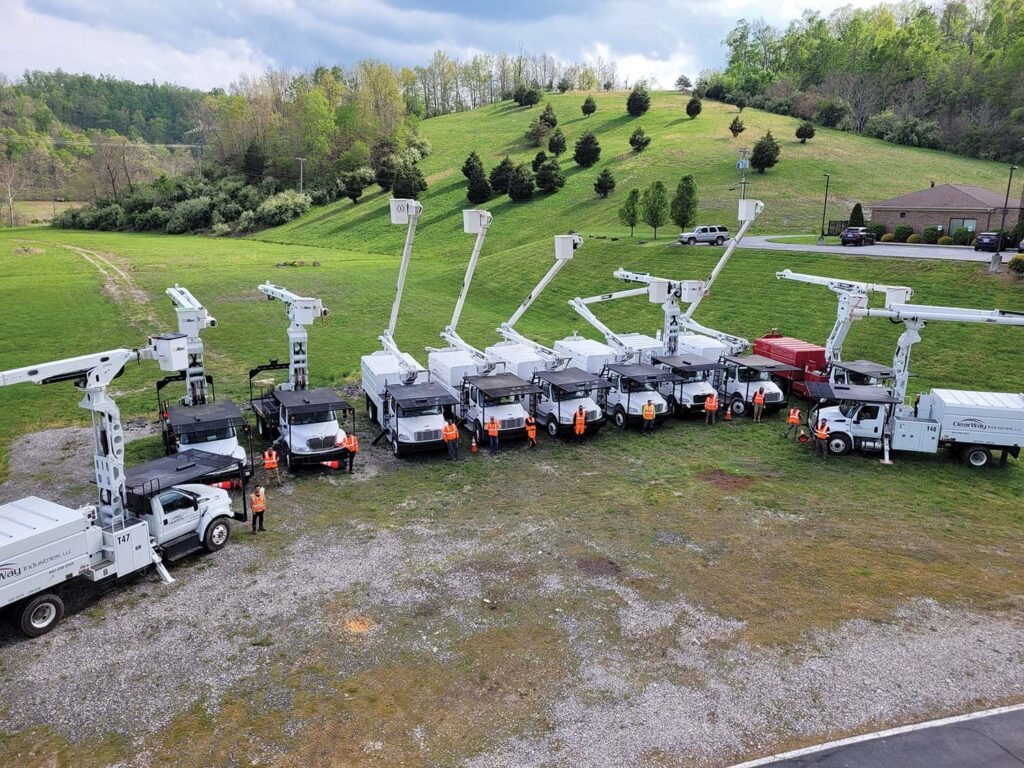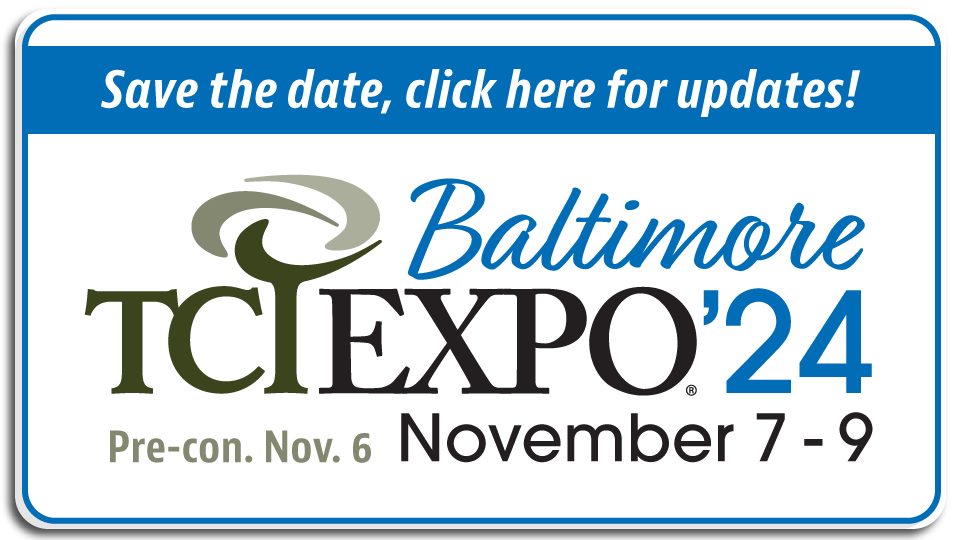Incorporating Fleet Telematics: Pros and Pitfalls
Telematics is a tool that may help lower insurance premiums, as well as address other fleet-related issues and expenses, but only if used in conjunction with company policies and programs that encourage or enforce better driving habits. And if not used properly, it could hurt more than help.

“Having telematics is great, but managing the data it provides is the most important thing,” says Rory Anderson. TCIA file photo courtesy of ClearWay Industries LLC, a utility-contractor accredited, nine-year TCIA member company based in Glenwood, New Jersey.
That is a conclusion drawn from the opinions expressed in a brief and informal survey of a handful of insurance agents and brokers that work with tree care companies. All agreed there are pros and cons when incorporating fleet telematics into fleet operations.
Eric Petersen, president, ArboRisk Insurance, an 11-year TCIA corporate member company based in New Berlin, Wisconsin. He also is a member of TCIA’s Board of Directors.
“For me, the use of telematics is a very important part of a successful driver and fleet-management program. It allows the tree service to utilize data gathered by the software to make risk-management decisions with their drivers and vehicles, thereby taking away the subjectivity of rewarding or disciplining employees based on their driving. The data gathered also can help the safety team create or reinforce proper driving techniques during safety meetings. If the tree service is committed to helping each employee get home safely each night, installing a telematics system is a great way to reinforce that commitment to every employee,” says Petersen.
“There are a lot of different ways to use this technology, and I’ve seen more and more tree care companies begin to embrace it. That said, there still are more who are hesitant to start using telematics than there should be.”
Q: What potential pitfalls do you see with telematics programs?
A: “Not selling it correctly to your team on the initial implementation. If leadership doesn’t get the buy in from all employees, there will be resentment and potential for employees to deactivate or try to work around the technology, which will lead to greater exposure than not having it.
“The purpose for the telematics must be clearly communicated to the team and be genuinely focused on the safety of the drivers and general public. If your employees feel the installation of the telematics program is a way to keep track of your employees’ every move, you won’t have success implementing it.”
Q: Is there anything else you think company owners or managers need to know about telematics as it might relate to their insurance coverage or premiums?
A: “When a tree service takes ownership of the responsibility to reduce their over-the-road exposure, they position themselves to not only receive lower insurance rates, but, more important, to avoid wasting time dealing with an auto accident. The indirect cost associated with an auto accident is often many times more costly to the business than the actual accident itself. If installing a telematics program can reduce accidents for your company, then you will be saving time and money simply by not having to deal with those accidents.”
Rory Anderson, commercial insurance broker and account executive with the Tree Care Group, Rancho Mesa Insurance Services Inc., a four-year TCIA corporate member company based in San Diego, California.
Q: Is there anything insurers look for or advise for consideration when a company is incorporating telematics into their fleet?
A: “Having telematics is great, but managing the data it provides is the most important thing. It’s what you do with the data that is so important.”
Q: Is there any potential reduction in premiums?
A: “Yes, however, there isn’t an objective credit the carriers can apply (5%, 10%, etc.) – it’s more subjective. When the underwriters are considering the risk, they want to know whether or not you have fleet telematics. It’s a question I get asked on every single auto fleet. They are taking it into consideration when offering terms, if they can draw conclusions that the implementation of fleet telematics is improving the loss experience.”
Q: What potential pitfalls do you see with telematics programs?
A: “Lack of managing the data, expecting simply that implementation will help.”
Q: What does the insurance company need to see (proof of installation?) to consider a credit on insurance premiums?
A: “Knowledge of implementation and, in many cases, loss improvement.”
Q: What software features are the most important to the insurance company (GPS tracking, vehicle-maintenance statistics, dash cams, driving data, etc.)?
A: “All.”
Q: Is there anything else?
A: “It is critically important for companies that utilize telematics to take action on the information. When it comes to driving habits, if the data suggests driver behavior that is concerning, the employer should address this information with training/corrective action. Simply ignoring the data could be considered willful negligence on the part of the employer.”
Mark Shipp, CIC, senior executive vice president, HUB International Insurance, a 28-year TCIA corporate member company headquartered in Santa Barbara, California.
Q: Is there anything insurers look for or advise for consideration when a company is incorporating telematics into their fleet?
A: “Any advancements in this direction are positive in my view. We advise that driver-facing and outward-facing cameras increase driver awareness, create a defensible position when incidents occur and provide an opportunity to reward defensive-driving behavior. In order for telematics to be effective, there must be an internal champion. The software is of little use if not managed properly.”
Q: Is there any potential reduction in premiums?
A: “Yes. Over time, with claims-experience-reduction and discretionary-premium-reduction considerations.”
Q: What potential pitfalls do you see with telematics programs?
A: “It is possible that it could provide proof of poor driving behavior.”
Q: What software features are most important to the insurance company?
A: “Dash cams and driver data.”
Q: Is there anything else?
A: “Auto risk management is one of the most serious considerations a tree care company needs to make with their safety program. One of the sayings that I think appropriately characterizes the need is, “We are all trucking companies that happen to prune trees.” There must be compliance with state and federal requirements. It is incumbent on the leadership of tree companies to know how they are viewed by regulators.”
Jeffry Blackman, CTSP, program manager, ArborMax Insurance Program, a 20-year TCIA corporate member company based in Mount Pleasant, Michigan.
Q: Is there anything insurers look for or advise for consideration when a company is incorporating telematics into their fleet?
A: “They will want details on the type of telematics used and the data collected. Is information looked at in real time, daily, weekly, etc.? How are the policies communicated to employees? How are alerts or policy violations handled? Is there a formal written policy for violations? Does the policy include driving restrictions or firing for repeated violations?”
Q: Is there any potential reduction in premiums?
A: “Possibly. In most states, underwriters have some amount of discretionary credit or debit they can apply to pricing. The use of telematics is one of many underwriting factors. Evidence of distracted-driving policies, personal-
use policies and MVR (motor vehicle record) reviews also has an impact on the premium. The caveat is that there needs to be evidence these policies are actually enforced, as opposed to just pages in the safety manual that are not discussed or enforced.”
Q: What potential pitfalls do you see with telematics programs?
A: “Telematics are not magic. Regardless of what types are used, they will not improve driving habits unless there are written policies around driver expectations and reprimands for policy violations.
“If you implement telematics but don’t have written polices around acceptable driving that are enforced, you are documenting negligent driving habits. In the event of a lawsuit resulting from an auto accident, this information will be subpoenaed. If you install telematics but ignore poor driving habits, having telematics in place is worse than doing nothing.”
Q: What does the insurance company need to see to consider a credit on the insurance premiums?
A: “Subscription information as well as copies of their driving policies and details of what is done for drivers when they are generating alerts from the telematics.”
Q: What software features are the most important to the insurance company?
A: “I think that is a business decision that is different for each owner or fleet manager. I would start by asking what they hope to get from telematics, e.g., reduce their frequency of accidents, improve employee productivity, confirm that employees are not using cellphones while driving, reduce vehicle wear caused by aggressive driving? All of these can be addressed by telematics.
“For example, GPS and driving data provide additional information beyond safety. Poor driving habits are hard on equipment. Knowing the location of company vehicles may shed light on employee inefficiencies. Oil and temperature data can be early warning signs of issues. The use of forward-
facing cameras can help determine who is at fault in the event of an accident. Dash cams can help improve (the habits of) inattentive drivers.”
Q: Is there anything else?
A: “The first question is always, ‘Is there an insurance discount if we use telematics?’ This is the wrong question. In my opinion, this is similar to attitudes toward safety a few decades ago. Telematics are one tool that can help to create safer driving habits, reduce wear on equipment and protect your public image.
“Will implementing telematics save you money over time? Yes, but they are not magic. In order to harvest the benefits of telematics, policies have to be created. These policies have to outline what are acceptable driving habits and be clearly communicated to employees.”
Thomas Doherty, senior vice president of national programs, NIP Group/TreePro, a 25-year TCIA corporate member company based in Woodbridge, New Jersey.Regarding any potential reduction in premiums, Doherty says some underwriters are starting to base premiums on miles driven. If that becomes a trend in commercial insurance, then telematics will be key in tracking vehicle mileage.
Q: What potential pitfalls do you see with telematics programs?
A: “If not properly managed, telematics can create significant risks for companies. The data collected by telematics systems can potentially expose the company to liability if it shows that employees are consistently speeding, braking harshly or driving at unsafe distances (from the vehicles around them) – and the company fails to address these behaviors.
“If a company has access to this information and does not take corrective action, it could be seen as negligent. In the event of an accident involving one of their employees, this data could be used to establish a pattern of unsafe practices, potentially leading to higher claims and demands. This underscores the importance of not only collecting telematics data but also actively using it to promote a strong safety culture and enforce safe driving behaviors.”
Q: Is there anything else?
A: “Telematics can be a protective shield for companies that implement them effectively. By using the data gathered from telematics systems, companies can build a strong safety culture and enforce proper behavior among their employees. This includes ensuring that drivers adhere to proper speed limits, use appropriate braking techniques and maintain safe following distances.
“Additionally, companies can monitor vehicle usage to ensure that employees who take company vehicles home use them strictly for work-related purposes and not for personal use. This approach can significantly enhance safety and reduce risks, ultimately protecting the company and its assets.
“Telematics is poised to become a critical tool for businesses, especially those focused on safety. Companies that leverage telematics to establish strong safety procedures and enforce positive behaviors will not only protect their employees and assets but also gain a competitive advantage. By fostering a safety culture, these businesses will be better positioned to safeguard their operations and positively impact the communities they serve.”
Don Staruk is TCI Magazine editor, a position he has held for most of his 21 years with the magazine.




